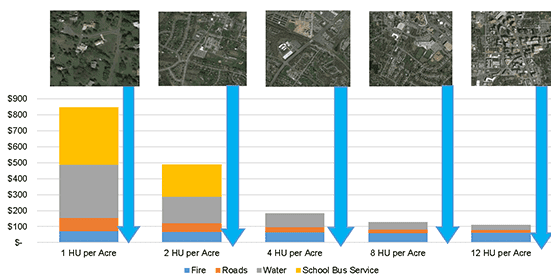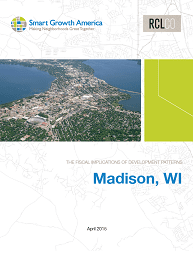Strategic Market Analysis: A Critical Component of Successful Corridor Revitalization

As trends in development focus on walkable, mixed-use communities, one of the challenges faced by communities is revitalizing outdated strip center retail, underutilized commercial space, and car-oriented corridors into places that appeal to both residents and tenants. Revitalizing a corridor requires the expertise of many different fields, including transportation, engineering, urban design, and strategic market and financial analysis. Understanding the market dynamics and potential of a corridor is an essential component of redevelopment efforts, but it is challenging to balance potential future market opportunities with current market realities. This Advisory highlights a few key market principles to aid in creating a revitalization strategy that capitalizes on market opportunities along a corridor.
Segment the Corridor Into Focused, Market-Oriented Nodes
Strategically segmenting the corridor into specific nodes makes it possible to concentrate redevelopment efforts into smaller areas that are easier to manage and will effectively accommodate a variety of economic opportunities. As relevant market dynamics and infrastructure can vary dramatically along corridors, characterizing these activity centers and differentiating them from one another from a market perspective helps determine what can thrive in each area. Differentiated centers of activity can act as catalyst projects from which development will spread outward along the corridor, sustaining a variety of uses made possible by current and future market conditions.
Virginia Beach has implemented a strategic plan along I-264, dividing the corridor into eight “strategic growth areas” (SGAs). As the market and current use of each SGA varies, the strategic plan focuses on a different mix of uses at varying density for each SGA that is based on an evaluation of the SGA. Since the SGAs were identified in 2003, the Virginia Beach government has started infrastructure improvements for the Burton Hill area, including widening a congested road, adding a landscaped median, and building a pedestrian and biking path. In this primarily residential and service-oriented retail neighborhood, the infrastructure improvements pave the way for better multimodal connectivity, updating and attracting new retail, and incorporating greenspace. Simultaneously in the denser tourism-focused Resort SGA, 31Ocean, a mixed-use plaza with pedestrian- friendly residences, retail, hotel, and offices, officially opened in January 2013. The apartments (first move-ins March 2013) are 70% occupied with an average rent of $1.71 per square foot, and the 50,800 square feet of retail is 83% leased with an average rent of $31.00 per square foot. Following the suggestions of the Resort SGA Master Plan, the mixed-use area provides a gateway and neighborhood feel to the resort area of Virginia Beach and sets an example of the mixed-use community that the Virginia Beach Resort SGA hopes to create.
Acknowledge Market Realities and Dynamics of the Corridor and Plan Accordingly
Breaking the corridor into strategic areas facilitates determination of market-supported potential growth while also acknowledging the reality of existing infrastructure, buildings, market dynamics, and land use patterns that will affect redevelopment. As the ultimate goal of corridor revitalization is to create an economically thriving place, strategic planning should realistically consider the opportunities and limitations of the existing market. Although streetfront retail and mixed-use districts are aesthetically desirable and appealing to users, a corridor dominated by light industrial and warehouses may not be feasibly and economically suited for conversion to a dense mixed-use environment. Strategically evaluating the market and planning accordingly will aid in smooth and effective corridor revitalization. Part of the effort is acknowledging the current market realities (e.g., rents only justify stick-built, walk-up apartments), but planning for or incentivizing the type of development desired (e.g., in order for the market to build denser apartments, the local government may need to assist with parking).
Revitalization efforts for U.S. Route 1 in Howard County, Maryland, began in 2000 with plans to re-establish a blighted residential, commercial, and industrial corridor with denser, mixed-use development. However, with existing light industrial and office properties entirely oriented to automobiles, ground floor retail was out of place and did not lease well. Acknowledging the economic importance of the light industrial and office buildings, Howard County has re-strategized the corridor planning to maintain and aesthetically improve commercial properties while creating small areas of denser, walkable retail and residential development. The plans have been successful as 2,280 rental apartment units have been brought to the market since 2000 at approximately 4.0% vacancy. The county is currently in the process of evaluating and making comprehensive zoning changes, using categories such as Commercial Redevelopment, Corridor Activity Center, and R-A-25 for mixed-use developments, and Business Rural Crossroads (BRX) district for rural business ventures. By making these zoning changes, the county is aiming to expedite development as property owners will not have to seek zoning changes and the county has the ability to strategically guide development.
Continuously Monitor the Market and Adapt Plans and Development to the Market
Establishing a strategic plan that is adaptable to changes in the market helps a corridor adjust to changes as the market develops. This also ensures timing corresponding to market needs and demands as they arise.
On Route 1 in Fairfax County, Virginia, efforts have been underway to revitalize Richmond Highway between Fort Belvoir and the Huntington Metro station since 1981. The Richmond Highway strategy originally planned for significant mixed-use development (hotel, office, residential, retail) that has not occurred as development has concentrated in other parts of Northern Virginia. However, with time and the rapidly growing D.C. and Northern Virginia area, investments in the corridor have steadily increased, with $166 million of residential and retail development currently in the pipeline. Most notably, a 143,416 square foot Costco is under construction (opening June 2013), and the Beacon of Groveton residential and retail community opened in September 2012 after 10 years of planning. The apartments are 45.8% leased with an average rent of $2.14 per square foot. Through constant evaluation of the market, Richmond Highway has been able to capitalize on proper timing and product, resulting in successful projects bringing life back to the corridor.
Although corridor redevelopment requires considerable time and collaboration, progress is being made as governments and developers respond to the challenges of redesigning outdated strip retail centers and car-oriented communities. Following the tactics described above of segmenting the corridor into nodes of development focused on the realities and intricacies of market demand and growth, Route 1 in Fairfax and Howard County and I-264 in Virginia Beach have succeeded in beginning the revitalization process. Through understanding the progression of development within these corridors, lessons in best practices and strategic planning can be applied to other areas to initiate revitalization efforts to benefit communities.
Disclaimer: Reasonable efforts have been made to ensure that the data contained in this Advisory reflect accurate and timely information, and the data is believed to be reliable and comprehensive. The Advisory is based on estimates, assumptions, and other information developed by RCLCO from its independent research effort and general knowledge of the industry. This Advisory contains opinions that represent our view of reasonable expectations at this particular time, but our opinions are not offered as predictions or assurances that particular events will occur.
Related Articles
Speak to One of Our Real Estate Advisors Today
We take a strategic, data-driven approach to solving your real estate problems.
Contact Us







